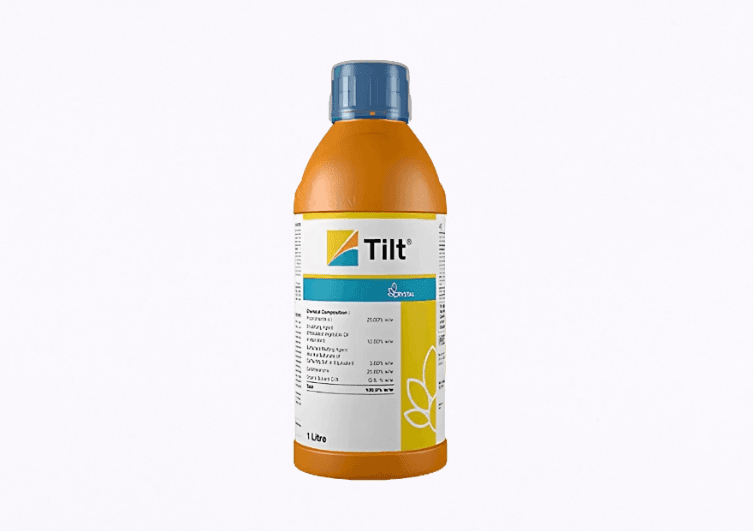
7 Ways Tilt Fungicide Protects Your Crops from Diseases
Learn how Tilt Fungicide provides superior crop protection. Learn about its benefits, application timing, safety precautions, and purchasing considerations.

Agriculture requires protecting crops from diseases for a bountiful harvest and
maintaining food security. Tilt fungicide is a great option in this fight against fungal infections. In this blog, we'll look at ways Tilt Fungicide offers crop protection by looking into its features and benefits. As well as essential information about its application, safety precautions, and buying considerations.
Overview of Tilt Fungicide

Tilt Fungicide, commonly known by its active ingredient propiconazole, is a systemic broad-spectrum fungicide designed to tackle various fungal diseases in various crops.
Propiconazole belongs to the triazole group of fungicides, and it is widely used to combat fungal growth. Tilt works by interfering with fungal cell membrane formation, stopping disease spread while protecting crops.
Ways of Tilt Fungicide Offering Crop Protection
Let's now examine seven ways Tilt Fungicide can protect your crops against various diseases:
1. Broad Spectrum Protection
One of the key advantages of Tilt Fungicide is its broad spectrum activity, providing effective crop protection from an array of fungal diseases - including:
- Powdery mildew
- Rust and Septoria
- Leaf Spot
- Fusarium Head Blight
- Leaf Blotch
- Eyespot (leaves with darkened spots).
Tilt's versatility makes it an excellent solution for farmers dealing with multiple fungal threats or who are uncertain about the disease that's impacting their crops. By using just one product against multiple diseases, they can possibly cut costs associated with multiple fungicide purchases.
2. Systemic Action to Provide Comprehensive Coverage
Crystal Tilt Fungicide operates through systemic action, meaning it is absorbed by plants and distributed throughout their tissues. This mode of action offers multiple advantages. For instance:
Uniform protection
Tilt provides uniform crop protection by spreading its fungicide throughout a plant's entirety, even the hard-to-reach corners.
Curative and preventive action
Its curative and preventative action effectively addresses all areas of infection.
Rainfastness
Once applied, Tilt becomes rainfast, eliminating the need for frequent reapplication after rainfall.
Extended protection
Due to its systemic nature, Crystal Tilt can offer longer-lasting crop protection than contact fungicides.
3. Rapid Absorption and Fast-Acting Formula
Tilt Fungicide is quickly absorbed by plants within an hour after application, providing immediate protection. This quick uptake serves several important purposes.
Immediate Protection: With rapid uptake comes instant protection.
Lower risk of wash-off: Quick absorption reduces the chance that your product could be washed away by unexpected rainfall.
Flexible Application Timing: Tilt's fast-acting nature allows more flexible application schedules during busy farming seasons - something that may prove particularly helpful.
4. Enhance Crop Vigour and Yield Potential
Tilt has been observed to have multiple beneficial impacts on overall plant health and productivity:
Greening Effect: Many farmers report seeing a visible "greening effect" after applying Tilt.
Stress Tolerance: Tilt can help plants better tolerate environmental stresses, such as drought or temperature variations.
Yield Improvements: By controlling diseases effectively and improving plant health, Tilt can contribute to increased yields and better crop quality.
5. Flexible Application Methods
Tilt Fungicide can be applied in several different ways, allowing maximum flexibility based on your equipment and preferences.
Ground application: Tilt Fungicide can be applied using conventional ground sprayers.
Aerial Application: Ideal for aerial spraying in large fields with difficult ground conditions or when ground conditions require extra care in terms of soil structure and drainage.
Chemigation: Chemigation applications can also be applied through irrigation systems in certain crops for uniform distribution and to reduce labour costs.
6. Compatible with Integrated Pest Management (IPM) Programs
Tilt Fungicide technical can easily fit into Integrated Pest Management programs:
Tank mix compatibility
Tilt can be mixed with many crop protection products to apply fungicides, insecticides, or fertilisers simultaneously.
Assist in resistance
Tilt can also assist in managing resistance when used as part of a rotational program using various modes of action fungicides.
Minimal Impact on Beneficial Organisms
When used according to its directions, Tilt has minimal effects on non-target organisms, making it ideal for biological control methods.
7. Cost-Effective Disease Control Solutions
Tilt Fungicide can initially cost more than other alternatives; however, its overall value proposition makes it a cost-effective choice:
Reduced application frequency
With long-lasting protection provided by Tilt, fewer applications over the growing season will be needed for full protection.
Multi-disease control
Because Tilt's broad spectrum activity addresses multiple diseases simultaneously, you will no longer need to purchase multiple products for each condition.
Yield protection
By effectively controlling diseases and protecting yield potential through Tilt, you will enjoy higher profits and achieve increased yield protection.
Quality improvement
Increased disease control can often lead to better-quality crops that command higher prices in the market. Tilt Fungicide can help!
Time of Application of Tilt Fungicide
The optimal time and frequency of applying tilt wheat fungicide can differ depending on factors like crop, disease pressure, and environmental conditions; however, here are some general guidelines:
Preventive application: Use at early signs of disease development or when conditions favour its spread.
Early growth stages: Many crops benefit from applications applied during early growth stages to protect new growth and protect new seedlings.
Regular intervals: Apply treatments according to disease pressure and weather conditions at regular intervals.
Pre-harvest interval: Always comply with the pre-harvest interval specified on the label to ensure crop safety and comply with regulatory requirements.
Weather conditions: Apply when rain is not expected for at least 2-3 hours after application to ensure proper absorption.
Crop-specific timing: To find out the appropriate crop application timing recommendation, consult your product label or local agricultural extension services.
Safety Precautions When Applying Tilt Fungicide

Tilt Fungicide is a great tool for crop protection; however, its safe use must always come first:
Protective Equipment (PPE) as Stated on the Label: PPE should include gloves, a long-sleeved shirt, pants, and closed-toe shoes (typically).
Avoid drift: Apply in calm weather conditions in order to minimise drift to non-target areas.
Protect water sources: Do not apply directly to surface water bodies such as lakes and rivers, and ensure buffer zones exist around them.
Proper storage: Keep in a cool, dry location away from food and feed sources and out of reach of children and pets.
Disposal: As required by local regulations, discard empty containers and unused products according to any applicable instructions.
Re-entry period and first aid procedure: Prior to entering treated areas without protective gear, observe the specified re-entry interval and familiarise yourself with first aid procedures in case of accidental exposure.
What to Consider When Purchasing Tilt Fungicide
When purchasing crystal tilt Fungicide, keep the following factors in mind.
Crop Compatibility: Verify the Tilt is approved to be used with the specific crop in your region.
Disease Spectrum: Confirm that Tilt effectively combats the diseases you're targeting.
Package Size: Select an optimal package size that meets both your farm size and application needs.
Expiration Date and Storage Requirements: Please ensure the expiration date meets the requirements for optimal use during your growing season.
Storage Requirements (for Organic products): Confirm that storage facilities meet those set forth by this product's manufacturer.
Local regulations: Be mindful of any local restrictions or regulations surrounding Tilt Fungicide use.
Cost-effectiveness: Compare Tilt to other fungicides when considering its broad spectrum activity and long-lasting protection capabilities.
Supplier Reputation: When buying, choose from a reliable supplier to ensure you're purchasing a genuine product.
Technical Support: Consider obtaining technical support from either the manufacturer or distributor.
Average Tilt Fungicide Dosage to Use
Tilt Fungicide dosage will depend upon various factors such as crop type, disease pressure, and local regulations:
Tilt Fungicide can typically be applied at rates ranging from 2 to 8 fluid ounces per acre, with the exact dosage being determined by factors like crop type, growth stage, and severity of disease pressure. Common application rates in wheat include 4 fluid ounces per acre; in corn, applications can range between 2 and 4 fluid ounces per acre.
Due to the differences in crop types, Tilt Fungicide dosage recommendations can differ drastically. Higher rates can be recommended in curative treatments or under severe disease pressure, while lower rates might be more suitable for preventative uses.
The frequency of application also impacts Tilt Fungicide dosage throughout the growing season. Tilt should generally be applied every 14 to 21 days, depending on disease pressure and environmental conditions; however, please pay attention to any maximum amounts permitted per season listed on its label to avoid overuse and potential resistance development.
Bottomline
Tilt Fungicide from Spray Karo provides a powerful and versatile solution to protecting crops against various fungal diseases. Its broad-spectrum activity, systemic action, and rapid absorption make it a reliable choice for farmers looking to safeguard their yield and maximise yield potential.
FAQs
1: In what timeframe does Tilt Fungicide become effective after being applied?
Tilt Fungicide can quickly absorb into plant tissues, typically becoming rainfast within 1 hour of application under ideal conditions. For best results, however, apply when no rainfall is expected at least 2-3 hours post application to allow complete absorption into all plant tissues for maximum efficacy.
2: Can Tilt Fungicide be combined with other pesticides or fertilisers?
Tilt Fungicide can be mixed with many other crop protection and fertilisers; however, always read and follow any label instructions regarding mixing instructions or compatibility information before mixing in large volumes. Conduct a small-scale compatibility test prior to adding other products into a spray tank mix in this order: water-soluble packets, wettable powders, water-dispersible granules (including Tilt), liquid flowable (such as Tilt), emulsifiable concentrates (including Tilt) then surfactants (along with other products from these orders). Whenever in doubt regarding compatibility issues, consult either your local agricultural expert or manufacturer for advice -
3: For how long does Tilt Fungicide provide crop protection?
Tilt Fungicide's length of crop protection varies based on factors like disease pressure, environmental conditions, and crop growth rate. Under normal conditions, it should provide coverage for 2-3 weeks; however, shorter intervals between applications may be required in cases with high disease pressure or rapid plant growth. Always consult your label instructions regarding any necessary applications to your crop and region.
4: Is Tilt Fungicide safe for beneficial insects such as bees?
Tilt Fungicide have minimal effects on beneficial insects such as bees when used according to label instructions. However, as an extra precautionary measure, it should be avoided when bees are actively foraging in its treatment area. Therefore, it's recommended that Tilt Fungicide be applied either early morning or late evening when bee activity is low, and local regulations and best practices regarding pollinator protection should always be adhered to when applying any pesticide product.
3: Is Tilt Fungicide suitable for organic agriculture?
Unfortunately, Tilt Fungicide is not approved for use in certified organic farming systems as its active ingredient is propiconazole, which is prohibited under most organic certification standards. Organic farmers should seek alternative fungicides approved for organic production, such as copper-based or biological options, for optimal disease management options. If you are exploring organic production or considering transitioning over, speak to your certifying agency or agricultural extension service about approved disease management solutions before making their choice.
